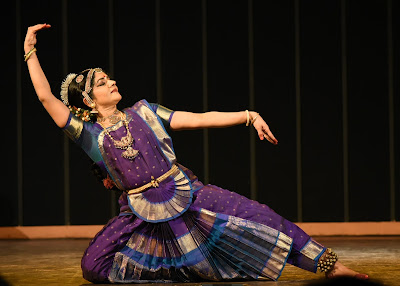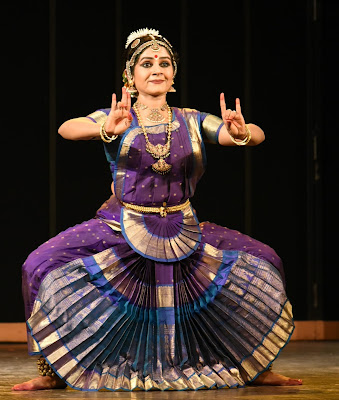Doing raas to celebrate the love of Krishna
Usha RK has this knack for organizing events which are conceptually very innovative, even though they stick strictly to the classical repertoire. The latest in her series on temples, which has so far included two events, Shiva Kshetre and Devi Kshetre (which is also on this blog), was Krishna Kshetre. Krishna is Paramatma and is known to exist in every entity. Yet he manifests himself in certain places to give darshan to his devotees. The two pilgrimages presented here were Udupi and Vrindavan. Ushaji started her compering for the evening with ‘Om Devaki Nandanaya Vidmahe’. As always, her announcements are detailed and comprehensive, and give you an insight into the performance.
Udupi
Bharatanatyam dancer Ragini Chandrashekhar presented Krishna as the Dasara Deva of Udupi. Ragini is the daughter and disciple of renowned Bharatanatyam exponent Jamuna Krishnan, and has been trained by other gurus including KN Dakshinamoorthy Pillai. Udupi is located in Karnataka. The famous Krishna temple and the Tulu Ashta Mathas are situated here. The mathas were founded by the Vaishnavite saint Jagatguru Shri Madhavacharya in the 13th century. He was the founder of the Dvaita school of Vedanta.
 |
| Ragini Chandrashekhar (Pic: Anoop Arora) |
The performance by Ragini began with a pushpanjali in ragam Mohanam, set to mishra chapu talam, composed by Vidwan Rajkumar Bharathi. The lord in Udupi is beautiful, it says, with a garland on his neck. The pushpanjali was followed by a composition of Mohandasa, which addresses Udupina Krishna. In the pushpanjali, Ragini portrayed Krishna with a morpankha on his kirit and a flute in his hand. The lord holds a churner or a mathani in one hand. She depicted the ball game and the Kaliya daman for this sequence. Her footwork had a lot of precision and the leaps showed a lot of agility. The depiction of Krishna dancing on the hood of the serpent, with one hand holding its tail, showed a lot of dexterity. Ragini could easily bring out the playfulness of the dancing god.
 |
| Pic: Anoop Arora |
The next composition, by Saint Mohandasa, addresses the lord to say, how do I go across the bhavasagar? I am a poor humble bhakt who simply wants bhakti and enlightenment at your feet. Oh my lord, reclining on the shesha, kindly get me across the ocean of bhava. Ragini’s expressions of the bhakt were very impressive and the vocalist, Sudha Raghuraman, made the composition quite expressive.
 |
| Pic: Anoop Arora |
The next piece, by Purandardasa, in ragam Brindavani, aditalam, describes the beauty of the dancing deity, Shri Krishna. He wears diamond-studded jewellery around his neck, which dances with him. The morpankh and the mukut on his head sway with him. The music, in which the sound of bells was prominent, was very lively, with rhythmic patterns and mimetic syllables. He who is the father of Manmatha is dancing with abandon, He is surrounded by gopis who are drawing immense pleasure from his darshan. The shankha and chakra are in his hands, the lotus garland in his neck is swaying. His adornments and bracelets, his waistband, are all mesmerizing. The effect of Krishna’s dance is also seen on nature, which is dancing with him. The birds are dancing, the bees are dancing — the peacock dance by Ragini was especially graceful. The curls and kundal on his cheeks are like bees on lotuses. ‘Yaduvir, mukunda, sukumar, purandar vithala’ are the names he is addressed by. Ragini’s nritta was excellent in pace and technique, her feet arching as she jumped on her toes. The expressions of Krishna as a cowherd, with the calves looking lovingly up at him, gave you the feeling of being there.
 |
| Pic: Anoop Arora |
The third composition was a small introduction to the temple as well. The temple is in the state of Karnataka, and is also known as Rajatha Peetha and Shivalli. During the festival of Janamashtami, men wear peelivesha. It has been the seat of Shri Madhavacharya and his mathas since the 13th century. In the Hindu temples, the deity always faces the east. But in Udupi, Krishna faces the west. The story sis that Kanakadasa, an untouchable bhakt, waited for days to be let into the temple for a darshan. He sang numerous kirtans from outside the temple. And finally, the lord turned from east to face the west, and there was a crack in the wall, the Kanakanakhindi, which is a window that opened for Kanakadasa to get a darshan of the lord. The lord has always made his bhakts and bhakti superior to caste. Here, in this composition, the bhakt pleads, ‘Please give me your darshan, oh Narahari. When you were reclining on the Adishesha with Lakshmi at your feet, the Gajendra called out, ‘Adimoole!’, you were there on your Garuda to rescue him from the grasp of the makara. As Hiranyakashyapu questioned your existence, to save the little Prahlad, you broke open the pillar and vanquished the demon king. You came to Draupadi’s rescue and extended her sari. Why are you so merciless with me? Please open the door and let me have a glimpse of you.’ He finally got the darshan from the Kanakanakhindi. The composition was in raag Mallika, khanda chapu talam. As the composition suggests, it required the depiction of not only the pinings of the bhakt, but the enactment of all the episodes and characters. Ragini was able to essay the despondence of the bhakt, and finally, his elation at getting darshan, with saatvik bhavas. Her enactment of the Gajendra moksha was also commendable. Ragini did full justice to the piece, making it memorable for her audience. Truly a moment of spiritual joy.
The choreography was Ragini’s, with Jamuna Krishnan helping with the visualization, ideation and abhinaya. K. Vageesh did the poetic research and selection, while accomplished vocalist and musician Sudha Raghuraman brought her own compositions alive in her memorable voice. Contributing the rhythmic structure and inputs, and on the nattuvangam, was Karaikudi K. Shivakumar, while Krishna’s favourite instrument, the flute, was played almost as skilfully by the always wonderful G. Raghuraman. The other accompanists included Raghavendra Prasath on violin and Ragini’s accomplished husband, M.V. Chandrashekhar, on mridangam.
--
Vrindavan
Vrindavan was the next tirth to be revisited. I have not been to Udupi, but I have been to Vrindavan very often since it is in north India. Vrindavan has its own attraction for Krishna bhakts, since it has places which are still untouched by modern civilization, and show signs of the Krishna avatar. Vrindavan is the abode of Vrinda or tulsi groves. Shri Haridas built the shrine of Nidhivan here, where the prakatya bhoomi or the site of manifestation of Lord Bihari ji is present. Even the Mughal emperor Akbar acknowledged the spiritual vibes of the place. It is said that in the night, these lata or branches become the gopis to serve Radha and Krishna in their vihar.
 |
| Sangita Chatterjee (Pic: Anoop Arora) |
Kathak dancer Sangita Chatterjee is the disciple of Vaswati Misra. The first piece she performed was ‘Shyam murat man bhayi, dekhat chhavi Braj Shyam’, with music by Pt Birju Maharaj. This blended into the Kaliya Daman leela. The water of Yamuna was poisoned by the serpent Kaliya, and all the beings in and around it were dying. Krishna jumps into the river, fights and vanquishes the demon and dances on his hood. In Sangita’s depiction, the lotus feet of Krishna are reddened by the jewels on the serpent’s head. The composition was in raag Megh, taal devda and dhamar, text compiled by Shrimad Prabhupad, ISKCON, from Bhagavata Puran. Sangita’s depiction of Krishna, with the morpankh, kirit, the peacock dance and the flute on his lips, was done well. The fight between Krishna and Kaliya, and the serpentine movements of the serpent, showed Sangita’s expertise. Finally, she did the tandava on the hood of Kaliya. The leelas and the vasant ritu of Vrindavan are Krishna’s favourite. ‘Naval vasant naval Vrindavan’ was the next composition. When the fresh breeze or sameer blows, the madhup or the bee is on the kusum shakha. The entire piece was followed by nritta, rendered in rhythm.
 |
| Pic: Anoop Arora |
The reference in the next piece was to the Govardhan puja in Braj. The Brajavasis would pray to Lord Indra to bless them with rain for their crops. They would prepare chhapan bhog for the puja. Kanha tells them their god is not Indra but Govardhan parvat, which brings them rain and protects them. The annoyed Indra lashes Brajabhumi with ferocious rainfall, and people, cattle and birds start drowning. Krishna lifts the giri or mountain on his little finger to protect Braj. The abhinaya was simple and expressive, taking the audience through the tale.
 |
| Pic: Anoop Arora |
And finally, Sangita performed the maharaas on the full moon night of the month of Kartik. The moon is shining high in the sky, with the environs illuminated by the moonlight. Nature prepares to have Krishna at the Yamuna tat (bank), with blooming lotuses and flowers, a gentle breeze blowing. Krishna plays on his flute to call the gopis, who leave their families and households to unite with him. They are all performing various chores when the flute begins to play. They get intoxicated – ‘maadit’ – by the flute, dress and leave. The Navakumar and Radha are in the centre, Krishna with gopis on the sides — ‘noopur kankan kinkini baaje, manjul murali baaje’. The gopis want to have him on both sides of them, and each gopi then has one Krishna on either side of her. Sangita has a perfect hold on her technique, which was apparent in her nritta and the chakkars for the final piece.
 |
| Pic: Anoop Arora |
The choreography was Sangita’s, while for her music, which was pre-recorded, the tabla was by Utpal Ghoshal, the sitar by Sunilkant Saxsena, vocals and harmonium by Anirban Battacharya, flute by Rajat Prasanna, and Rahul Pawar on padhant.


Comments
Post a Comment